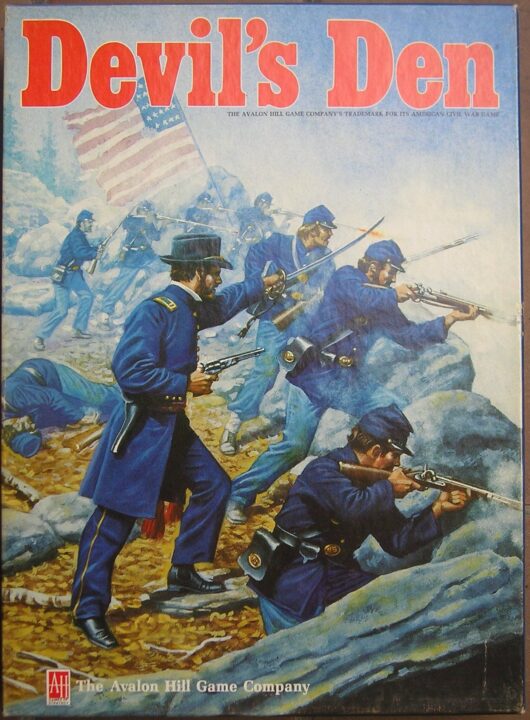Ever wondered what it feels like to wrangle chaos, double-cross your friends, and question your own life choices, all in one evening? Well, you’re in the right place. This is my honest review of Devil’s Den, the board game that had my game group yelling across the table and occasionally plotting my downfall over a bowl of pretzels. If you want to know whether you should risk eternal damnation—or just a couple of annoyed texts from your friends—keep reading.
How It Plays
Setting up
First, dump all the pieces on the table. Watch them scatter. Realize you should probably read the setup card. Each player grabs a Den board, random tokens, and a handful of sneaky goblins (not real goblins, sadly). Place the Devil figure in the center, because every good game starts with a little chaos right in the middle. Shuffle the deck, deal cards to everyone, and keep your snacks at least one foot away from the components. Trust me, grease is not a power-up.
Gameplay
Now, players take turns moving their goblins, playing cards, and trying to outwit their rivals. This usually means looking innocent while you plot betrayals. Each round, you pick cards to either attack, defend, or stir up trouble. Special tiles on the board do wild stuff, like swapping places or summoning fireballs. Expect table talk, bluffing, and the odd bit of yelling about who stole whose treasure. If your goblin gets toasted, don’t worry, you can respawn with only mild emotional trauma.
Winning the game
The game ends when the Devil escapes, or when a player scores enough loot (or victory points, if you wanna be boring about it). Whoever has the most points at the end wins. Prepare for bragging rights, fake curses, and someone demanding an immediate rematch. If you win on your first try, expect accusations of cheating or witchcraft. It’s all part of the fun.
Want to know more? Read our extensive strategy guide for Devil’s Den.
Gameplay Flow and Player Interaction in Devil’s Den
So, let’s talk about the gameplay flow in Devil’s Den. Picture a Friday night with snacks, drinks, and five very competitive friends—which is exactly how I first played this game. Devil’s Den starts strong right out of the gate. Each player takes their turn in an order that never feels forced or confusing. There’s no long downtime, which means you won’t have to scroll through social media waiting for your turn. That’s a great win in my book, because nobody wants to hear about Aunt Linda’s cat pictures during game night.
Interaction between players comes fast and furious. Whether you’re negotiating, sabotaging, or just trying to win, the game keeps everyone involved. When I played, I couldn’t help but enjoy the little twists and turns. It felt like everyone at the table had a real chance to mess up my plans. My friend Steve tried outsmarting us, only to find out teamwork in Devil’s Den can shift faster than my opinion on pineapple pizza. The board itself creates natural choke points, which lead to some hilarious face-offs and plenty of opportunities to trash talk. And yes, I scored big only because two other players locked horns and forgot I was still in the game. Classic sneaky victory.
Devil’s Den does a great job balancing moments of cooperation with pure, unfiltered rivalry. You can’t just coast along quietly in this one; you need to talk, plan, and sometimes plead for mercy. If you’re looking for a game where sitting in the corner works, this isn’t it. But if you love getting into people’s heads and forcing dramatic choices, you’re in for a treat.
Get ready, because next, I’ll spill all the beans about how Devil’s Den handles the eternal tug-of-war between luck and strategy…
Is Devil’s Den All Skill or a Lucky Roll?
Let’s talk about the thing that keeps board gamers up at night: is it all brains or just luck? After a few evenings with Devil’s Den, this question haunted me more than the cursed tokens on the board. In Devil’s Den, strategy takes center stage for most of the game. You’re picking your path, planning a few steps ahead, and keeping a wary eye on your so-called friends who would sell you out for two coins and a mysterious key. You have real choices: block someone’s progress, steal that juicy treasure, or pull off a move so sneaky that everyone groans and starts plotting your downfall.
But – and it’s a flaming-hot but – luck creeps in like the devil himself. Those event cards? Sometimes they save you. Sometimes they send your whole plan crashing down, and you can kiss those victory points goodbye. There’s the thrill of not knowing exactly what’s coming, but when my pal Lucy pulled three perfect cards in a row, I swear I saw steam coming out of my ears. It’s not a game where dumb luck wins you the crown, but sometimes the lucky player feels a little too lucky.
If you want a pure chess match, Devil’s Den might leave you grumbling into your meeples. If you like scheming but don’t mind cursing fate, this one brings the right mix. Next up: We’ll see if the game looks as good as it plays, as I grab my magnifying glass and judge the component quality and artwork with the seriousness of a squirrel judging acorns!
Component Quality and Artwork in Devil’s Den: Eye Candy or Eye Sore?
When I first opened the box for Devil’s Den, my cat and I stared in awe for different reasons. She wanted the box (of course), but I couldn’t stop admiring those chunky wooden meeples. The pieces are satisfyingly weighty—none of those cheap, feather-light tokens you sometimes find in budget games. Everything feels like it was actually made for human hands and not for a seven-fingered octopus.
The board itself is thick and lays nice and flat, even after my friend Rick spilled a glass of cola on his first turn. The printing quality survived, which is more than I can say for Rick’s shirt. The artwork is where Devil’s Den struts its stuff, though. The illustrations are a bizarre mix of spooky and silly (think Tim Burton meets Saturday morning cartoons). It fits the gameplay perfectly—eerie enough to set the mood but playful enough to keep things from getting too heavy. The iconography is clear, and there’s just enough detail to make you look twice but not so much that it’s distracting. Even the rulebook is easy to read, with plenty of helpful pictures instead of endless walls of text. I genuinely appreciate that—I’m not here for a novel, I’m here for a good time!
Punching out those tokens was very satisfying, and absolutely zero cardboard carnage. That’s a win in my book. Next up, I’ll talk about replay value and the learning curve—so buckle up, because this game might surprise you in more ways than one!
Devil’s Den Replay Value and Learning Curve: Worth Playing Again and Again?
If you’re like me, you want a board game that won’t gather dust after one awkward family game night. Thankfully, Devil’s Den delivers plenty of replay value. Every time I break it out, the table feels a little different. The choices you make, the way players mess with each other, and the shifting board setup—they all keep things fresh. Even after five plays, I still haven’t found “the perfect move”—and I’m not sure it exists. My friend Greg swears he’s cracked the code, but he also once ate a playing piece, so I’m not convinced.
Let’s talk learning curve. Devil’s Den isn’t a walk in the park, but it won’t leave you staring at the rulebook either. I picked up the basics after one round of slightly confused play, and by the second game, my group was plotting and scheming like pros. The hardest part? Remembering to double-check the weird special moves. Thankfully, player aids help you out. I still made one boneheaded rule mistake during my fourth game, but nobody noticed—except my smug cousin, who doesn’t let anyone forget mistakes. Ever.
Best of all, Devil’s Den adapts well to different groups. Whether you’re playing with tactical masterminds or folks who just like to stir up trouble, everyone can have fun. That said, if your crowd hates thinking more than rolling dice, they might not love it as much.
So, do I recommend Devil’s Den? Absolutely. It’s smart, fresh, and full of surprises. Just keep the playing pieces away from Greg.
Conclusion
And there you have it, folks—my review of Devil’s Den wrapped up nice and tidy, unlike my friend Mark’s game night snacks (seriously, who brings soup?). I had a blast playing Devil’s Den, thanks to its quick turns and interactive play. The strategy is solid, the luck can be annoying, but not enough to make me flip the table. The art and pieces look great, and the replay value is high enough that I don’t mind dragging it out after a tough week. Yes, there’s a bit of a learning curve, but once you get the hang of it, games move along at a good clip. If you want a game that gets everyone scheming and laughing—plus a few groans when the dice don’t go your way—Devil’s Den is a great pick. Just remember: don’t eat the tokens, and watch out for soup. That’s it for this review. Time to pack up the board and start planning my next game night disaster!


